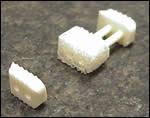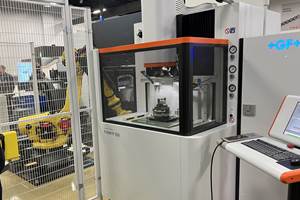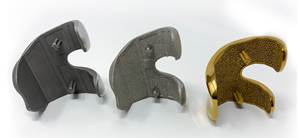From Donor To Shop To Surgery
This Florida shop machines bone to make surgical implants.
Every chip is precious at Regeneration Technologies, Inc. Rather than billets of metal alloy, the material RTI uses to produce its precision machined grafts is retrieved from donated human tissue. Located in Alachua, Florida, RTI processes bone, cartilage, tendons and ligaments to make implants used to repair and promote the healing of a variety of bone and tissue defects, for procedures including musculoskeletal reconstructions, mending bone fractures and repairing spinal vertebrae. These implants of human tissue from one person to another are called “allografts.”
RTI aims to reduce surgery time and improve convenience for surgeons. These aims are best accomplished by using human tissue (and soon, bovine tissue) that is shaped appropriately for the surgical procedure. The shaping is accomplished through CNC machining.
RTI applies CNC machining primarily to spinal allografts, including blocks, wedges, threaded dowels and rings used in cervical and lumbar procedures. The company’s Cornerstone ASR Cortical-Cancellous Block provides an example. This “engineered allograft” is multi-layer part made up of two cortical bone wedges (the outer hard part of bones) around a central, faster-healing cancellous bone section (the inner spongy part of bones). The three pieces are held together using press-fit bone pins. (See photo below.)
While the material and products are unusual, RTI’s machine shop is similar in many ways to more traditional shops. The company meets production deadlines, accommodates design changes, solves fixturing problems, provides prototypes and addresses a host of other concerns common to production.
Many of the differences that do exist are a matter of degree. For example, every machine shop is familiar with the importance of process work flow, the need for work area cleanliness and the challenges posed by batch-to-batch material variations. RTI machinists face these same issues. However, their machining environment makes the difficulties associated with these issues unusual indeed.
Work Flow
After the donor material arrives, it undergoes a rigorous screening process. The tissue is removed from the bone using a wire brush wheel or scalpel. The bone (such as a femur) is then sectioned into allograft blanks using a band saw. This process requires a fair amount of skill, with the experienced band saw operator planning the cuts in order to maximize the yield from a given bone.
The blanks are then machined using CNC lathes and mills. Pins are turned and sized using OmniTurn GT-Jr lathes, while milling is performed on Fadal 904-1L machining centers using dedicated fixturing and high speed steel or carbide tools. After any required assembly steps, the bone is sterilized using RTI’s “BioCleanse” process, which eliminates any bacteria, fungi, spores and viruses (and also leaves the bone appearing perfectly white). The bone is now able to serve as an inert scaffold that is absorbed into the body over time. In fact, once the surrounding bone has had a chance to grow into the grafted bone (many months after surgery), the implant is nearly impossible to detect in an X-ray. Lyophilization (similar to freeze drying) follows BioCleanse, and this process allows the final parts to be stored at the hospital without refrigeration. Packaging and inspection complete the production process.
Work Area Cleanliness
Protective clothing and related precautions also take on a different dimension for RTI machinists. Employees wear personal protection equipment, protecting both the bone from the machinist and (potentially) the machinist from the bone. Also, neither personnel nor equipment enter or leave the controlled production area “core” without cleaning or sterilization. All tooling is first treated with disinfectant, then it is wiped with isopropyl alcohol and dried before it can be taken into the clean area. For cutting fluid, RTI uses only isopropyl alcohol, a choice that is able to serve as a disinfectant, a lubricant assisting in chip removal and a drying agent.
Finally, for safety purposes, machinists are instructed to treat all tissue as though it were infected. If an injury were to occur in the core, then the machinist would be escorted out for medical care and tested for infection.
Batch-To-Batch Material Variations
For a more conventional shop, variations in metallic stock can include differences in machinability and mechanical properties, as well as machined part distortions related to residual stresses.
In a similar manner, RTI’s donors differ in age and sex, leading to variations in density, elastic modulus and yield strength. Even for one bone from a single donor, the properties can vary from one point to another. RTI addresses this problem by weighing the tissue prior to machining. This gives an indication of the bone density, which has been shown to be closely related to the material strength. If a minimum weight is not met, then the tissue is rejected.
Bone is also different from metals and plastics because it is anisotropic. This means that its properties vary with direction. Similar to wood, bone has a “grain,” and its strength varies with this grain direction. RTI considers this at the design stage. For example, the shop’s pin machining strategy requires that the grain direction be aligned with the pin axis.
Product Yield
It is critical to obtain an efficient number of grafts from the tissue. RTI’s combination of machining and assembly technology helps the shop achieve this goal. “Human anatomy limits the size of grafts. Assembly allows grafts to be made that could not be otherwise,” says Earl Jones, business unit manager. “An allograft for a 6-foot, 9-inch patient would have to be obtained from a donor of the same stature, without this technology.”
With increasing product demand comes even greater pressure to improve yield, which places demands on metrology and quality control. RTI recently partnered with researchers from the University of Florida Machine Tool Research Center to better understand causes for sporadic failure in the press-fit connections for the ASR Cortical-Cancellous Block. Donor variation seems to play a role, because elastic modulus and yield strength depend on bone density. Compounded with the variations in machined part dimensions and post-processing steps including BioCleanse and lyophilization, the overall result leaves RTI with the familiar quality-control difficulty of separating cause from effect.
In the ongoing study, tissues from multiple donors are being measured on a Brown & Sharpe MicroVal PFx coordinate measuring machine. The machining and assembly sequence is interrupted just prior to pin insertion. For each donor, half of the tissues are removed from the fixture and the rest are left in place. Hole and pin diameters are determined by touch-trigger probing, then the assembly process is continued for those tissues left in the fixture. By tracking the free and assembled parts through the remaining processes, RTI and UF hope to obtain a better understanding of the press-fit connection. Based on the relative dimensional variations following machining, BioCleanse and lyophilization, RTI can decide which of these processes requires a tighter level of control.
Machinist’s Perspective
Of course, the most uncommon aspect of RTI’s machining is the material itself. Jason Bootle, RTI machinist, describes a number of differences between cutting metal and cutting bone. Bone machining may be an unusual challenge, but for those who face it, here are some relevant points:
- Feed rates are typically lower for bone in order to avoid splintering (like wood).
- The machining center operator plays a key role in obtaining high yields. The blank must be positioned correctly in the fixture so that the cancellous bone is removed from the cortical bone without sacrificing the cortical plate size.
- The same tool is typically used for both roughing and finishing.
- Higher tooth passing frequencies can cause the outside surface of the part to be “singed.” In fact, the material smell generally changes under cutting conditions that are too aggressive.
- Tool life is generally not a concern, although the tools do dull eventually (within 1 to 2 months). Increased splintering
typically signals that a tool replacement is needed.
About the author: Tony L. Schmitz is an assistant professor with the University of Florida’s Machine Tool Research Center in Gainesville, Florida.
Related Content
EDM, Laser Micromachining and More at GF Medical Demo Center
At GF’s Medical Center of Competence, the company shows off EDM and laser features that could make a large impact on medical manufacturing — and elsewhere.
Read MoreArch Cutting Tools Acquires Custom Carbide Cutter Inc.
The acquisition adds Custom Carbide Cutter’s experience with specialty carbide micro tools and high-performance burrs to Arch Cutting Tool’s portfolio.
Read MoreANCA Introduces Tool Loading System for Medical Drills
ANCA’s dental drill loading kit includes tailored RoboMate pallets for FX machines using a FANUC 200iD robot loader.
Read More4 Ways 3D Printing Is Changing Medical Implants
Additive manufacturing provides new ways of making medical implants, but its impact is greater than this. How 3D printing is changing medical manufacturing and improving patient outcomes.
Read MoreRead Next
3 Mistakes That Cause CNC Programs to Fail
Despite enhancements to manufacturing technology, there are still issues today that can cause programs to fail. These failures can cause lost time, scrapped parts, damaged machines and even injured operators.
Read MoreThe Cut Scene: The Finer Details of Large-Format Machining
Small details and features can have an outsized impact on large parts, such as Barbco’s collapsible utility drill head.
Read More












.png;maxWidth=300;quality=90)

















